Abstract
Thirty-two adult patients with minimal change nephrotic syndrome (MCNS) were studied in order to clarify the characteristics of the immune system in MCNS and their relation to clinical activity. In the active phase (n = 17), serum immunoglobulin (Ig) M and E levels, B lymphocytes (surface Ig-positive cells) and their subsets, surface IgG, IgM and IgE positive cells; B gamma, B mu and B epsilon, were increased, whereas the serum IgG level and OKT3-reactive cells, peripheral T lymphocytes; T3, were decreased. In the remitted phase maintained by steroid therapy (n = 17), serum Igs and B lymphocyte subsets tended to return to normal levels concomitant with decreases in T3 and T4, and an increase in T8 in consequence of a marked decrease in T4/T8 (helper/suppressor) ratio. In stable remission continuing with no steroid therapy (n = 14), the above abnormalities returned to normal ranges, except for serum IgM which remained at a high level and re-elevated serum IgE. These results suggest that immunological abnormalities in MCNS are characterized by acceleration of the IgE and IgM producing systems and impaired maturation of the IgG producing system despite normal differentiation from the IgM producing to IgG producing system, possibly caused by T lymphocyte dysfunction.
Full text
PDF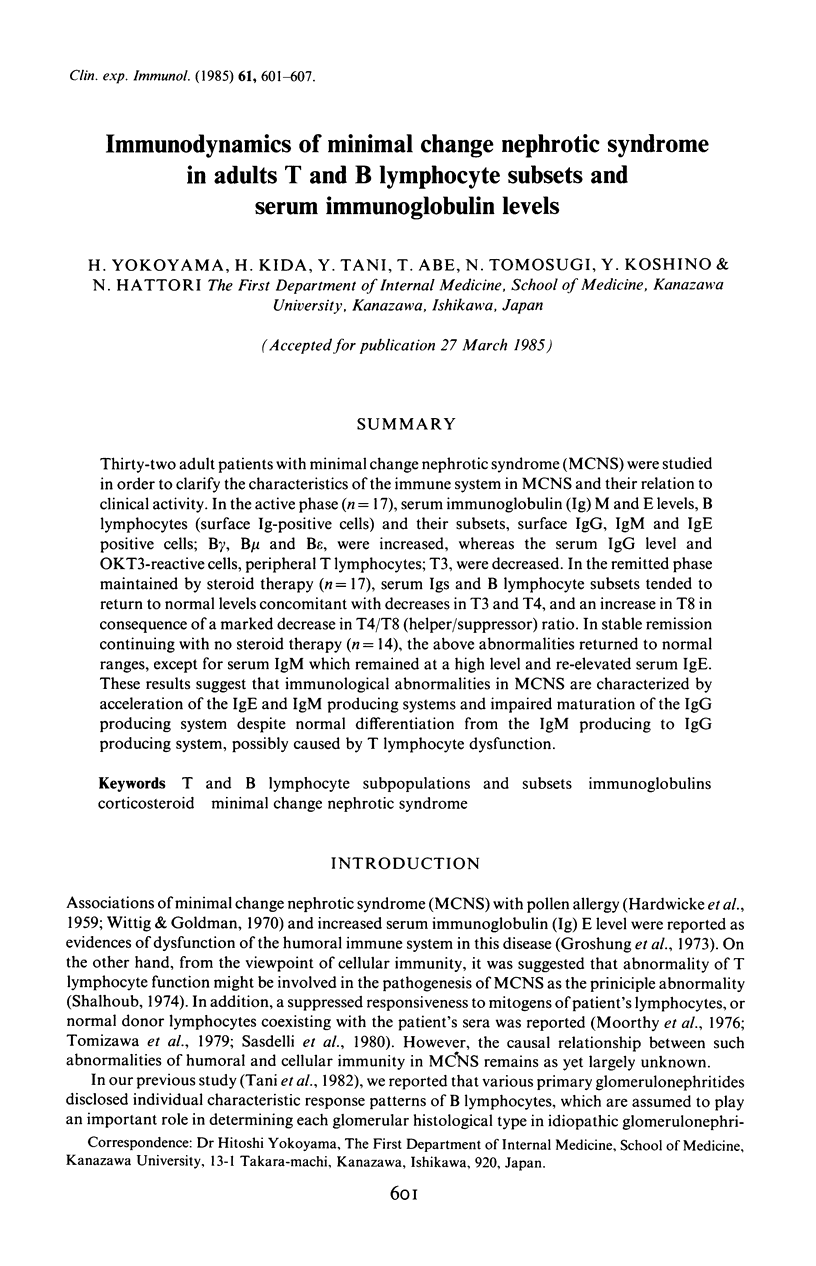
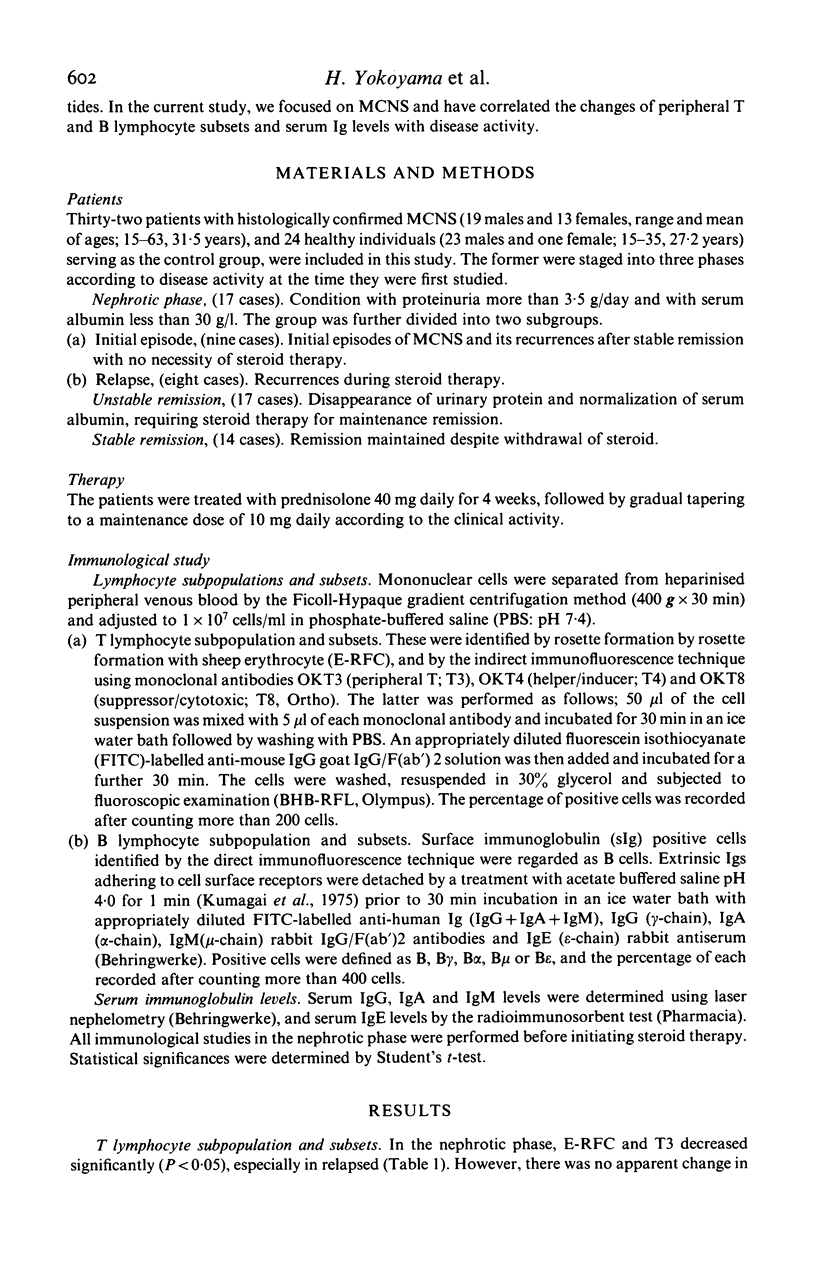
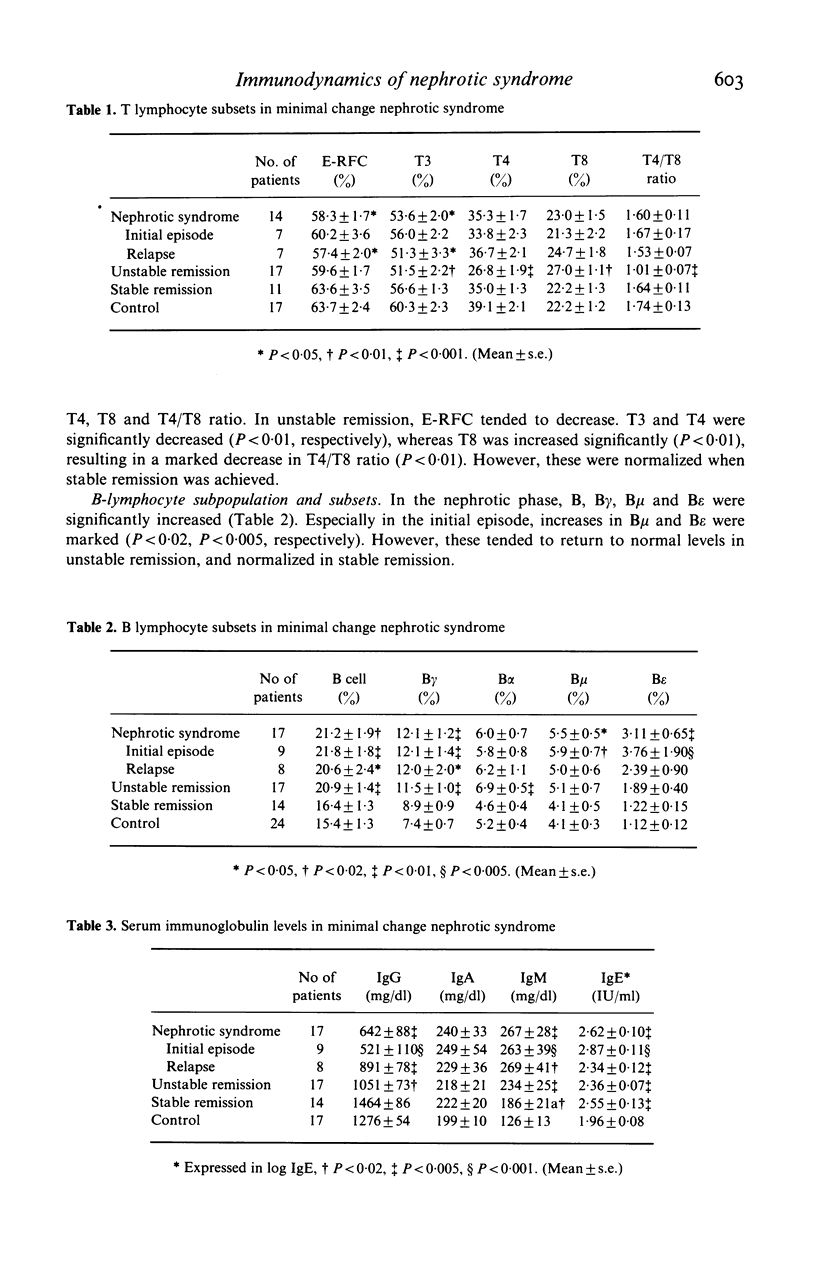
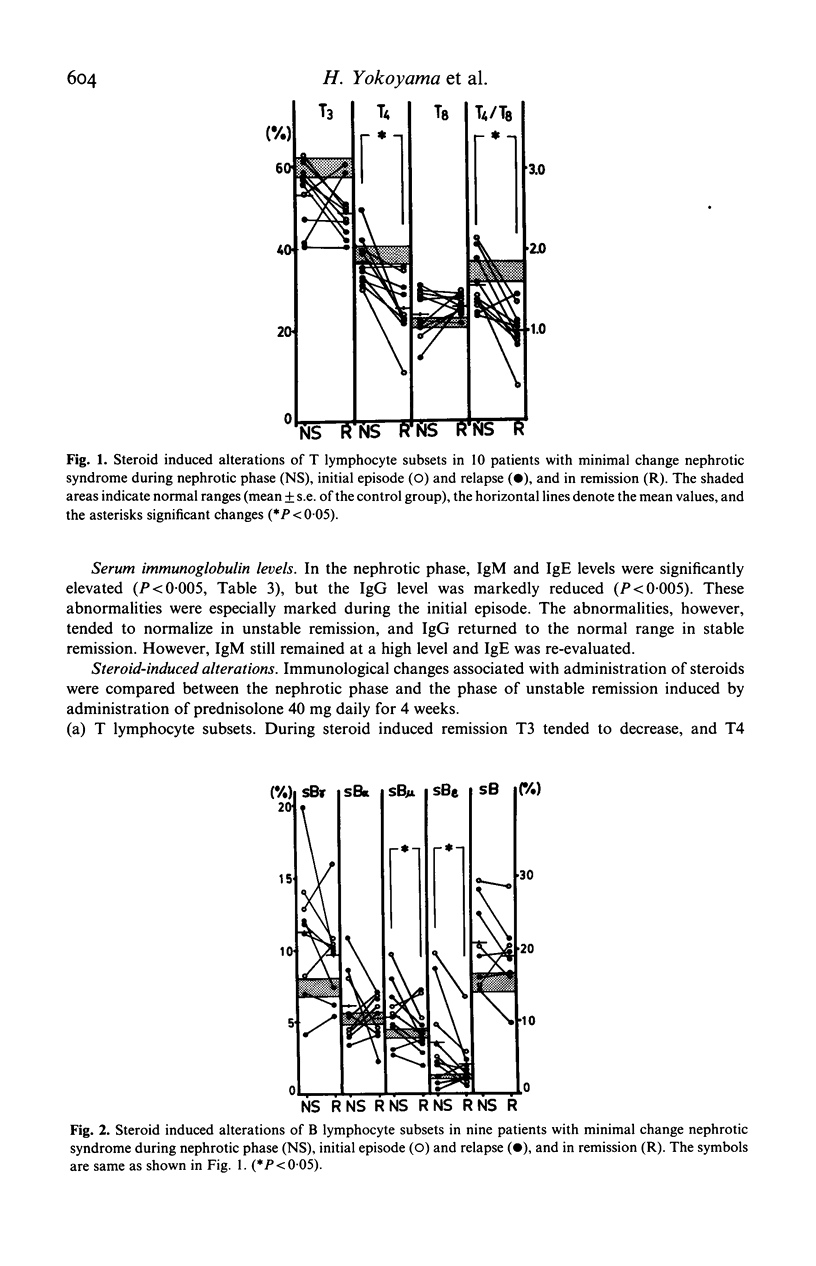
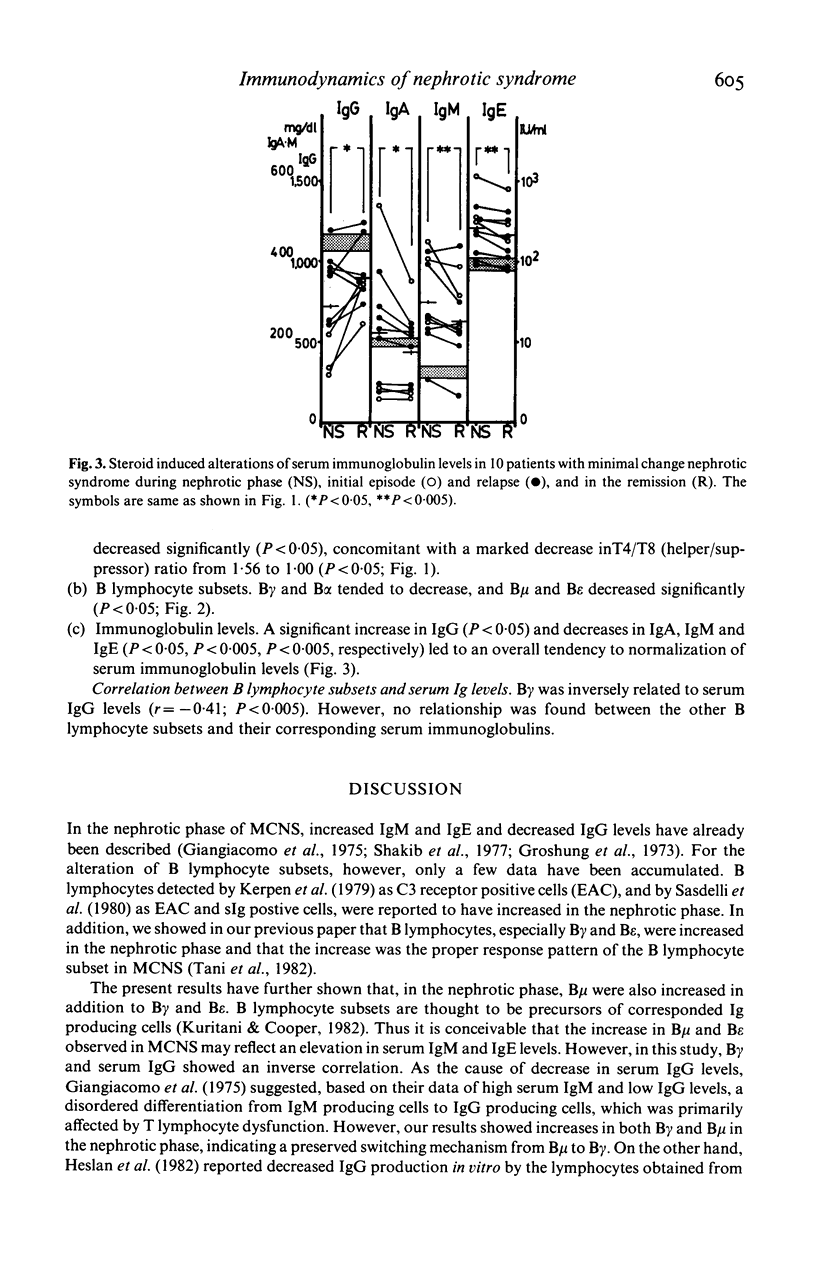


Selected References
These references are in PubMed. This may not be the complete list of references from this article.
- Giangiacomo J., Cleary T. G., Cole B. R., Hoffsten P., Robson A. M. Serum immunoglobulins in the nephrotic syndrome. A possible cause of minimal-change nephrotic syndrome. N Engl J Med. 1975 Jul 3;293(1):8–12. doi: 10.1056/NEJM197507032930103. [DOI] [PubMed] [Google Scholar]
- Groshong T., Mendelson L., Mendoza S., Bazaral M., Hamburger R., Tune B. Serum IgE in patients with minimal-change nephrotic syndrome. J Pediatr. 1973 Nov;83(5):767–771. doi: 10.1016/s0022-3476(73)80367-1. [DOI] [PubMed] [Google Scholar]
- HARDWICKE J., SOOTHILL J. F., SQUIRE J. R., HOLTI G. Nephrotic syndrome with pollen hypersensitivity. Lancet. 1959 Mar 7;1(7071):500–502. doi: 10.1016/s0140-6736(59)91026-8. [DOI] [PubMed] [Google Scholar]
- Heslan J. M., Lautie J. P., Intrator L., Blanc C., Lagrue G., Sobel A. T. Impaired IgG synthesis in patients with the nephrotic syndrome. Clin Nephrol. 1982 Sep;18(3):144–147. [PubMed] [Google Scholar]
- Kerpen H. O., Bhat J. G., Kantor R., Gauthier B., Rai K. R., Schacht R. G., Baldwin D. S. Lymphocyte subpopulations in minimal change nephrotic syndrome. Clin Immunol Immunopathol. 1979 Sep;14(1):130–136. doi: 10.1016/0090-1229(79)90133-8. [DOI] [PubMed] [Google Scholar]
- Kumagai K., Abo T., Sekizawa T., Sasaki M. Studies of surface immunoglobulins on human B lymphocytes. I. Dissociation of cell-bound immunoglobulins with acid pH or at 37 degrees C. J Immunol. 1975 Oct;115(4):982–987. [PubMed] [Google Scholar]
- Kuritani T., Cooper M. D. Human b-cell differentiation. I. Analysis of immunoglobulin heavy chain switching using monoclonal anti-immunoglobulin M, G, and A antibodies and pokeweed mitogen-induced plasma cell differentiation. J Exp Med. 1982 Mar 1;155(3):839–851. doi: 10.1084/jem.155.3.839. [DOI] [PMC free article] [PubMed] [Google Scholar]
- Moorthy A. V., Zimmerman S. W., Burkholder P. M. Inhibition of lymphocyte blastogenesis by plasma of patients with minimal-change nephrotic syndrome. Lancet. 1976 May 29;1(7970):1160–1162. doi: 10.1016/s0140-6736(76)91545-2. [DOI] [PubMed] [Google Scholar]
- Sasdelli M., Rovinetti C., Cagnoli L., Beltrandi E., Barboni F., Zucchelli P. Lymphocyte subpopulations in minimal-change nephropathy. Nephron. 1980;25(2):72–76. doi: 10.1159/000181756. [DOI] [PubMed] [Google Scholar]
- Shakib F., Hardwicke J., Stanworth D. R., White R. H. Asymmetric depression in the serum level of IgG subclasses in patients with nephrotic syndrome. Clin Exp Immunol. 1977 Jun;28(3):506–511. [PMC free article] [PubMed] [Google Scholar]
- Shalhoub R. J. Pathogenesis of lipoid nephrosis: a disorder of T-cell function. Lancet. 1974 Sep 7;2(7880):556–560. doi: 10.1016/s0140-6736(74)91880-7. [DOI] [PubMed] [Google Scholar]
- Tani Y., Kida H., Abe T., Tomosugi N., Saito Y., Asamoto T., Hattori N. B lymphocyte subset patterns and their significance in idiopathic glomerulonephritis. Clin Exp Immunol. 1982 Apr;48(1):201–204. [PMC free article] [PubMed] [Google Scholar]
- Tomizawa S., Suzuki S., Oguri M., Kuroume T. Studies of T lymphocyte function and inhibitory factors in minimal change nephrotic syndrome. Nephron. 1979;24(4):179–182. doi: 10.1159/000181712. [DOI] [PubMed] [Google Scholar]
- Trompeter R. S., Layward L., Hayward A. R. Primary and secondary abnormalities of T cell subpopulations. Clin Exp Immunol. 1978 Dec;34(3):388–392. [PMC free article] [PubMed] [Google Scholar]
- Waldmann T. A., Polmar S. H., Balestra S. T., Jost M. C., Bruce R. M., Terry W. D. Immunoglobulin E in immunologic deficiency diseases. II. Serum IgE concentration of patients with acquired hypogammaglobulinemia, thymoma and hypogammaglobulinemia, myotonic dystrophy, intestinal lymphangiectasia and Wiskott-Aldrich syndrome. J Immunol. 1972 Aug;109(2):304–310. [PubMed] [Google Scholar]
- Wittig H. J., Goldman A. S. Nephrotic syndrome associated with inhaled allergens. Lancet. 1970 Mar 14;1(7646):542–543. doi: 10.1016/s0140-6736(70)90770-1. [DOI] [PubMed] [Google Scholar]


